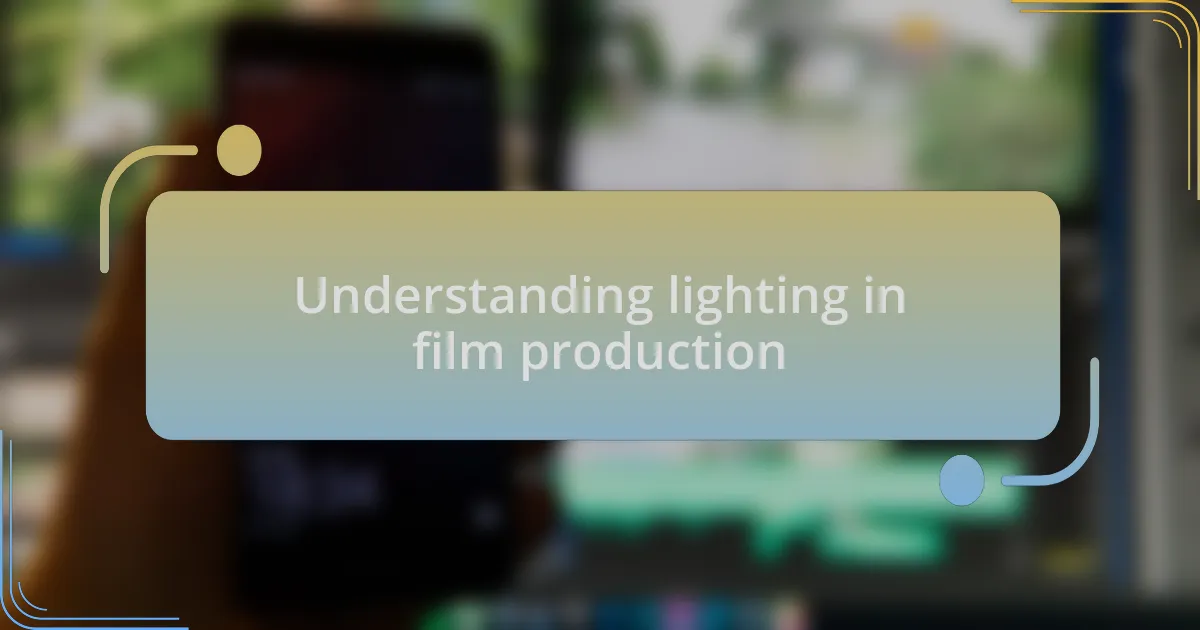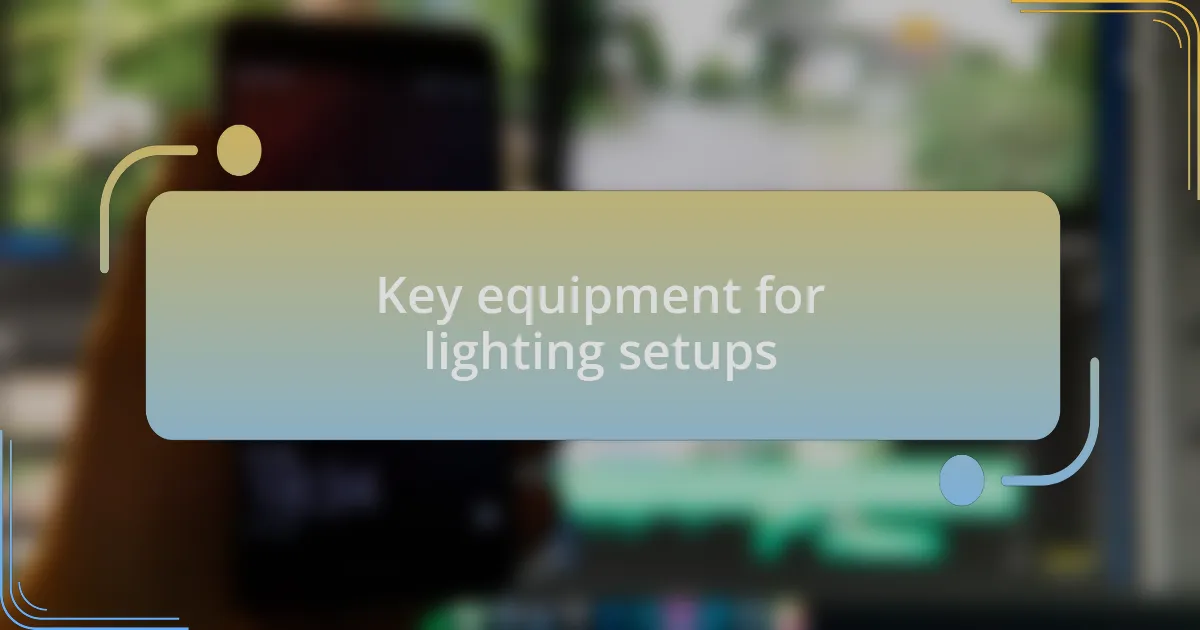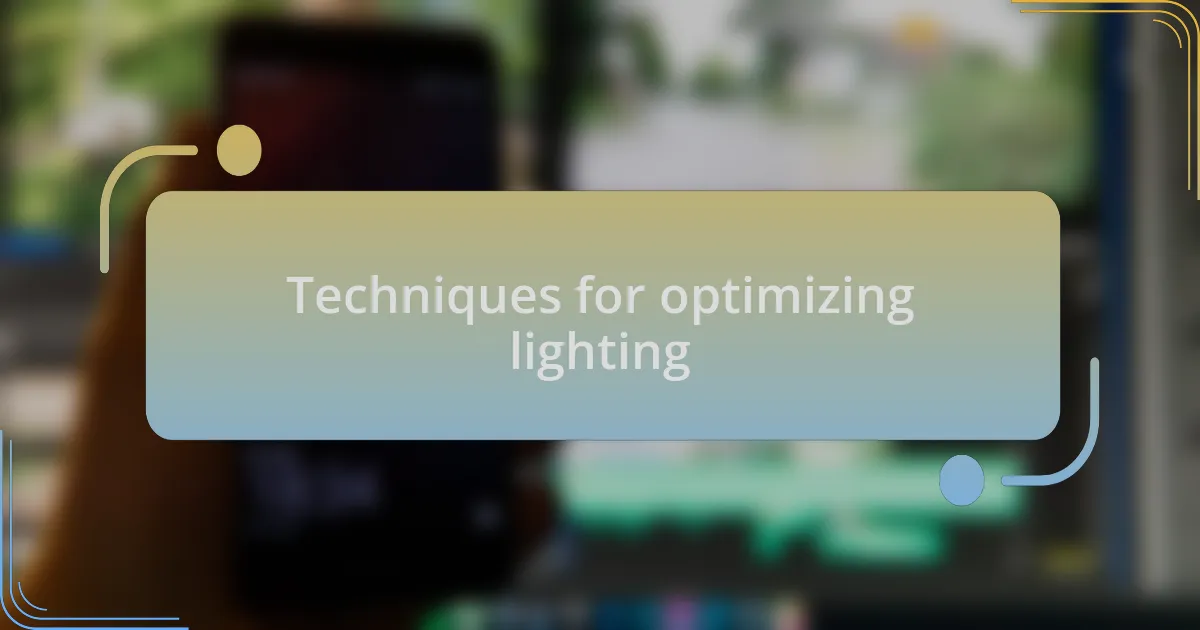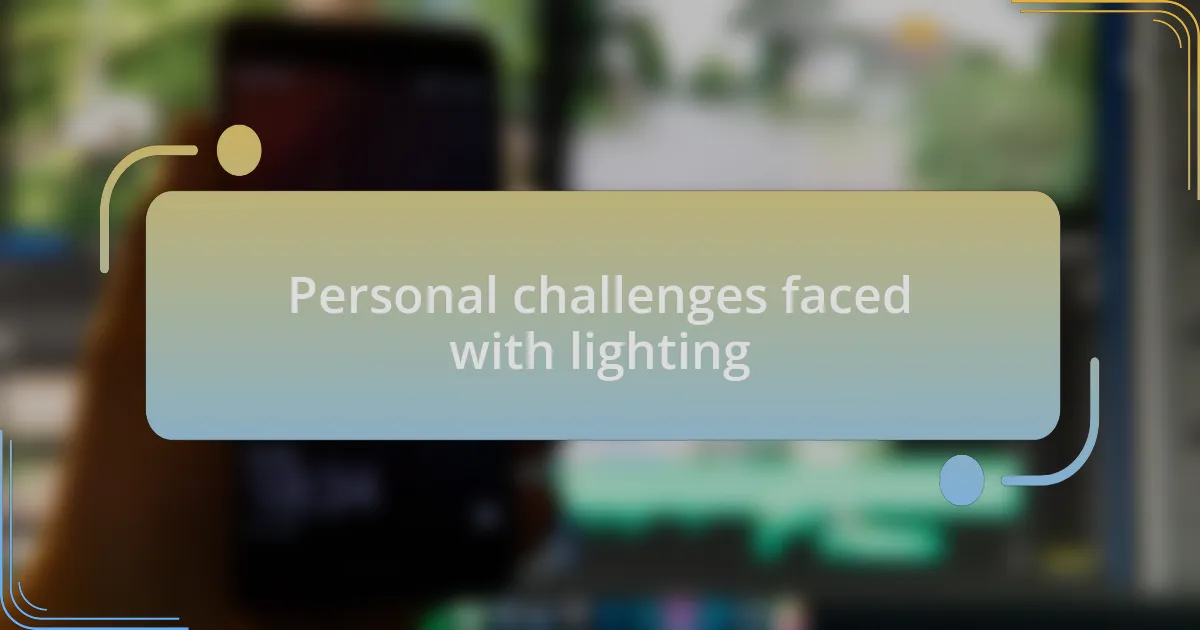Key takeaways:
- Lighting is essential in film production, as it creates atmosphere, conveys emotions, and enhances storytelling without dialogue.
- The use of key, fill, and backlighting helps highlight emotional nuances and adds dramatic tension to scenes.
- Techniques like three-point lighting and the use of bounce boards can optimize lighting and improve the overall visual narrative.
- Challenges with lighting, such as inconsistent natural light and color temperature mismatches, require adaptability and creative problem-solving.

Understanding lighting in film production
Lighting is often referred to as the unsung hero of film production, and I couldn’t agree more. I remember the first time I lit a scene—how the mood changed dramatically with just a simple switch of a light angle. It made me realize that lighting isn’t just about illumination; it’s about creating an atmosphere, conveying emotions, and telling a story without words.
One essential aspect I’ve learned is the importance of key, fill, and backlighting. By adjusting these elements, I’ve been able to highlight characters’ emotions and enhance dramatic tension. Have you ever noticed how the shadows can evoke a sense of mystery or fear? Those nuances in lighting can transform a flat image into something captivating.
Moreover, understanding the color temperature is crucial. I recall a project where we used warm lights to create a nostalgic feel, while cooler lights gave a scene a more clinical vibe. Isn’t it fascinating how a slight change in color can influence the audience’s perception and emotional response? The right lighting not only beautifies a shot but also deepens the audience’s connection to the story.

Importance of lighting for storytelling
Lighting plays an integral role in storytelling, shaping how viewers interpret each scene. I often reflect on a project where we used high contrast lighting to signify internal conflict in a character. It struck me how those stark shadows not only amplified the drama but also invited the audience to engage with the character’s emotional turmoil on a deeper level.
I remember experimenting with colored gels for the first time. It was fascinating to see how a pink hue could turn a simple scene of a family dinner into a warm, loving memory, while a harsh blue could evoke a sense of isolation. Those subtle shifts in lighting can make or break a viewer’s emotional connection; have you ever wondered why a romantic scene feels different from a suspenseful moment? The careful orchestration of lights does just that—guiding our feelings without uttering a single word.
As I explored different lighting setups, one thing became crystal clear: each choice has a narrative purpose. During one shoot, I deliberately undershot a character to create tension—a choice that left the audience almost holding their breath. Isn’t it exhilarating to realize that every light, shadow, and color not only serves the image but also propels the story forward? That’s the power of effective lighting: it elevates the narrative, transforming mere visuals into a profound emotional journey.

Key equipment for lighting setups
When it comes to lighting setups, a versatile softbox is often a must-have. I recall a project where I used a softbox to create diffused, even lighting that made a subject look incredibly natural. The ability to control harsh shadows was a game changer; I realized that softboxes not only aid in achieving a flattering look but also help direct the narrative tone—something I now prioritize in every shoot.
Next, let’s talk about LED lights. These have transformed my workflow significantly. I once completed an entire shoot using nothing but LED panels, and I couldn’t believe how lightweight and manageable they were. The adjustable color temperatures allowed me to mimic different times of day, enhancing the storytelling without needing to change locations. Isn’t it remarkable how a simple adjustment in lighting can completely alter the atmosphere of a scene?
Finally, I can’t emphasize enough the importance of light modifiers in a well-rounded setup. On one occasion, I added a grid to my key light, and the results blew me away. It focused the beam precisely where I needed it, creating depth and dimension that elevated the entire shot. Have you considered how light modifiers can fine-tune your vision? Each choice you make with these tools can open up endless creative possibilities, ultimately shaping the journey your audience experiences.

Techniques for optimizing lighting
One effective technique for optimizing lighting is the strategic use of bounce boards. I remember setting up for a music video when I placed a large white board to reflect natural light back onto my subject. The transformation was instant; the soft, diffused illumination eliminated unflattering shadows and created a warm glow that truly captured the mood of the song. Have you ever thought about how a simple reflective surface can change the dynamic of your shots?
Another approach I cherish is the practice of three-point lighting. It’s a classic technique that never fails to deliver depth and interest. I discovered its power during a corporate interview shoot; using a key light, fill light, and backlight not only separated the subject from the background but also added an inviting warmth to the context. Isn’t it fascinating how each light plays a specific role in telling a story, almost like characters in a film?
Lastly, controlling the ambient light is crucial in setting the right atmosphere. During a late-night shoot in a bustling city, I dimmed the existing lights and allowed my setup to dictate the mood. This experience taught me that sometimes, the better option isn’t to overpower the ambient light, but to embrace it, weaving it into the narrative fabric of my visuals. Have you explored the balance between your lighting setup and the environment? It could be the key to unlocking more impactful scenes.

Personal challenges faced with lighting
Facing challenges with lighting has been quite the journey for me. During a chaotic day on set, I encountered a glaring inconsistency in lighting due to shifting natural light. I thought I had my plan in place, only to see shadows creeping in as clouds passed overhead. It made me realize how unpredictable natural conditions can be—how do you adapt when nature decides to change the script?
One of the most personal hurdles I faced was dealing with the complexity of color temperature. I vividly remember grappling with mismatched lights while shooting a short film. The tungsten bulbs emitted a warm glow, while my LED lights skewed cooler. It took persistence and careful adjustment to find a compromise that resulted in a cohesive look. Have you ever experienced that sinking feeling when your lighting doesn’t match the vision in your head?
Lastly, I’ve struggled with equipment limitations and the learning curve that comes with it. On one occasion, I had to make do with an underpowered light fixture during a critical shoot. Instead of panicking, I improvised with practical lights available on set, enhancing the environment rather than relying solely on my original plan. It taught me to be flexible, embracing surprises instead of resisting them. How has improvisation changed your approach to lighting challenges?